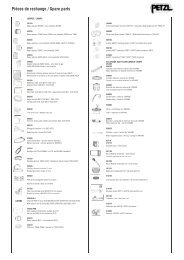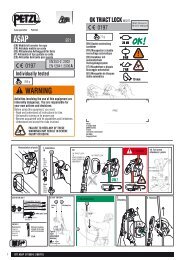You also want an ePaper? Increase the reach of your titles
YUMPU automatically turns print PDFs into web optimized ePapers that Google loves.
Technical information<br />
LED lighting<br />
LEDs (Light Emitting Diodes), or electroluminescent diodes, are the optoelectronic<br />
components designed to emit light.<br />
Some characteristics of LEDs:<br />
- as opposed to a standard incandescent bulb, they don’t use a filament<br />
- they consume less electricity and have a longer life than incandescent bulbs<br />
- LED technology allows for a multitude of shapes and colors<br />
Petzl headlamps equipped with LEDs first appeared in 2000 (TIKKA headlamp).<br />
Petzl headlamps use two types of LEDs:<br />
- cylindrical 5 mm diameter LEDs (ex: TIKKA, ZIPKA headlamps)<br />
- high-output LEDs (ex: MYO XP, TIKKA XP headlamps)<br />
Characteristics<br />
Energy consumption<br />
As opposed to standard incandescent bulbs, LEDs used in Petzl headlamps consume<br />
less electricity. This increases the burn time of our headlamps.<br />
Using the different lighting levels can help optimize electrical energy consumption.<br />
By choosing the strength of the beam, the quantity of light can be adapted to the activity<br />
and to lighting duration needs.<br />
Brightness<br />
LEDs are generally not as bright as incandescent bulbs. Their brightness decreases<br />
as their batteries become weaker.<br />
Brightness can be increased in two ways:<br />
- by increasing the number of LEDs in the same headlamp<br />
- by using an electronic device to temporarily increase the lighting level: Boost mode<br />
E.g. The TIKKA XP headlamp with Boost mode increases brightness by 50 % above<br />
maximum level for up to twenty seconds.<br />
Color<br />
For certain activities, like hunting or fishing, a colored light can be useful for discreet<br />
lighting or for helping to maintain night vision. This can be achieved with filters.<br />
E.g. red, green or blue filters for the TACTIKKA XP headlamp.<br />
Lens characteristics<br />
LEDs don’t all have the same optic characteristics:<br />
- Cylindrical, 5 mm diameter LEDs have an integrated lens. They don’t require Wide Angle<br />
lenses to create proximity lighting.<br />
- Power LEDs require an additional lens to concentrate the light.<br />
LEDs emit a much more uniform light than incandescent bulbs. This is partly due to the<br />
absence of a filament in LEDs.<br />
Electric power<br />
Because of the way they function, LEDs are polarized (cathode and anode). Therefore,<br />
it is important to insert the batteries in the right direction. If they are inverted, the LEDs<br />
will not work.<br />
Lighting performance will vary considerably according to the source of energy used.<br />
Light output<br />
When LEDs are powered at the levels defined by each manufacturer, they generally have<br />
greater output than incandescent headlamps.<br />
Lifetime<br />
The lifetime of an LED has been defined as the time up to which its flux remains above<br />
50 % of its original. For quality LEDs, this lifetime is close to 100 000 hours at standard<br />
voltage and current values. Under these conditions, the light output then becomes very<br />
weak (for signal lighting, etc.).<br />
With Petzl headlamps, the electric current is controlled, to provide a stronger lighting level.<br />
This allows an average lifetime of approximately 5000 continuous hours for LEDs.<br />
Durability<br />
With their molded, single capsule and their lack of a filament, 5 mm diameter LEDs are<br />
resistant to impacts and vibrations.<br />
Because of their design, high-output LEDs require additional protection from direct<br />
impacts. The lens can provide this function.<br />
www.petzl.com<br />
64 65<br />
Lenses<br />
Lenses are essential components for lighting. They allow the user to focus, to a greater or<br />
lesser degree, the light emitted from sources such as incandescent bulbs, fluorescent tubes<br />
or LEDs.<br />
Lenses are fixed or adjustable and allow the user to adapt the light beam to the activity and<br />
lighting needs.<br />
Reflectors act like mirrors, reflecting light in a given direction. Whether parabolic or flat,<br />
reflectors have an internal reflective surface with a mirrored appearance.<br />
Lenses are made of glass or plastic and be used to produce relatively compact devices.<br />
Depending on their shape, they can either diffuse or concentrate light rays.<br />
Depending on the light source, Petzl headlamps come equipped with:<br />
- a reflector (incandescent bulbs)<br />
- a lens (LEDs)<br />
Reflectors<br />
<strong>Headlamps</strong> equipped with an incandescent bulb have a specially designed reflector which<br />
concentrates the light emitted by the source forward. This particularly affects the light<br />
emitted to the sides and back of the bulb.<br />
The shape of each Petzl reflector is designed to precisely to ensure maximum efficiency<br />
in terms of output, beam uniformity, etc. Petzl reflectors are designed to limit imperfections<br />
in the beam due to the shape of the filament, the quality of the glass of the bulb, or the<br />
presence of two different light sources.<br />
Reflectors are generally covered by a protective lens.<br />
Incandescent light without reflector<br />
Adjustable focus<br />
Incandescent light with reflector<br />
Petzl headlamps with reflectors can be focused to adjust the width and distance<br />
of the light beam.<br />
Lenses<br />
High-output LEDs emit light around a 180° sphere. Lenses allow the entire beam to be<br />
concentrated forward of the headlamp, at the angle required. Petzl lenses are designed<br />
to maximize lighting efficiency in terms of output and beam uniformity.<br />
High-output LED without lens<br />
Wide Angle lenses<br />
<strong>Headlamps</strong> equipped with lenses emit a powerful, narrow, focused beam for lighting over<br />
long distances. To adapt this beam when there’s a need for wide-beam lighting, Petzl has<br />
designed a retractable Wide Angle lens made up of multiple micro-lenses.<br />
High-output LED with Wide Angle lens<br />
Special case: cylindrical 5 mm diameter LEDs<br />
High-output LED with lens<br />
These LEDs are used in certain Petzl headlamps and are composed of a lens as well<br />
as an internal reflector (support for light source). Because of this, they emit light at<br />
a predetermined and fixed angle.<br />
For more efficient lighting, Petzl adds a silver-colored finish to certain light bodies<br />
containing cylindrical LEDs.<br />
Reflector Lens<br />
Cylindrical LED (Ø 5 mm)<br />
Technical information





